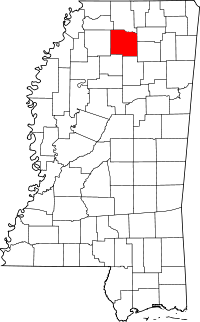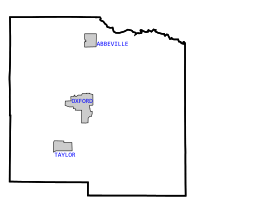Lafayette County, Mississippi
| Lafayette County, Mississippi | |
|---|---|
 Lafayette County courthouse in Oxford | |
 Location in the U.S. state of Mississippi | |
 Mississippi's location in the U.S. | |
| Founded | 1836 |
| Named for | Marquis de Lafayette |
| Seat | Oxford |
| Largest city | Oxford |
| Area | |
| • Total | 679 sq mi (1,759 km2) |
| • Land | 632 sq mi (1,637 km2) |
| • Water | 47 sq mi (122 km2), 7.0% |
| Population (est.) | |
| • (2014) | 52,930 |
| • Density | 62/sq mi (24/km²) |
| Congressional district | 1st |
| Time zone | Central: UTC-6/-5 |
| Website |
lafayettems |
Lafayette County is a county in the U.S. state of Mississippi. As of the 2010 census, the population was 47,351.[1] Its county seat is Oxford.[2] The local pronunciation of the name is "la-FAY-et". The county's name honors Marquis de Lafayette, a French military hero and American general who fought during the American Revolutionary War.[3]
The Oxford, MS Micropolitan Statistical Area includes all of Lafayette County.
Lafayette County is often regarded as the inspiration for Yoknapatawpha County, the fictional setting of many of William Faulkner's stories.
Geography
According to the U.S. Census Bureau, the county has a total area of 679 square miles (1,760 km2), of which 632 square miles (1,640 km2) is land and 47 square miles (120 km2) (7.0%) is water.[4]
Major highways
 U.S. Route 278
U.S. Route 278 Mississippi Highway 6
Mississippi Highway 6 Mississippi Highway 7
Mississippi Highway 7 Mississippi Highway 9W
Mississippi Highway 9W Mississippi Highway 30
Mississippi Highway 30 Mississippi Highway 334
Mississippi Highway 334 Mississippi Highway 331
Mississippi Highway 331 Mississippi Highway 315
Mississippi Highway 315
Adjacent counties
- Marshall County (north)
- Union County (northeast)
- Pontotoc County (southeast)
- Calhoun County (south)
- Yalobusha County (southwest)
- Panola County (west)
- Tate County (northwest)
National protected area
Demographics
| Historical population | |||
|---|---|---|---|
| Census | Pop. | %± | |
| 1840 | 6,531 | — | |
| 1850 | 14,069 | 115.4% | |
| 1860 | 16,125 | 14.6% | |
| 1870 | 18,802 | 16.6% | |
| 1880 | 21,671 | 15.3% | |
| 1890 | 20,553 | −5.2% | |
| 1900 | 22,110 | 7.6% | |
| 1910 | 21,883 | −1.0% | |
| 1920 | 19,243 | −12.1% | |
| 1930 | 19,978 | 3.8% | |
| 1940 | 21,257 | 6.4% | |
| 1950 | 22,798 | 7.2% | |
| 1960 | 21,355 | −6.3% | |
| 1970 | 24,181 | 13.2% | |
| 1980 | 31,030 | 28.3% | |
| 1990 | 31,826 | 2.6% | |
| 2000 | 38,744 | 21.7% | |
| 2010 | 47,351 | 22.2% | |
| Est. 2015 | 53,154 | [5] | 12.3% |
| U.S. Decennial Census[6] 1790-1960[7] 1900-1990[8] 1990-2000[9] 2010-2013[1] | |||
As of the census[10] of 2000, there were 38,744 people, 14,373 households, and 8,321 families residing in the county. The population density was 61 people per square mile (24/km²). There were 16,587 housing units at an average density of 26 per square mile (10/km²). The racial makeup of the county was 71.85% White, 25.05% Black or African American, 0.16% Native American, 1.67% Asian, 0.01% Pacific Islander, 0.42% from other races, and 0.84% from two or more races. 1.10% of the population were Hispanic or Latino of any race.
The largest European ancestry groups in Lafayette county are:[11]
Many people in Mississippi may claim Irish ancestry because of the term "Scots-Irish", but most of the time in Mississippi this term is used for those with Scottish roots, rather than Irish.[12]
In 2000, there were 14,373 households out of which 26.90% had children under the age of 18 living with them, 43.20% were married couples living together, 11.40% had a female householder with no husband present, and 42.10% were non-families. 29.10% of all households were made up of individuals and 7.80% had someone living alone who was 65 years of age or older. The average household size was 2.36 and the average family size was 2.97.
In the county the population was spread out with 19.50% under the age of 18, 27.10% from 18 to 24, 26.30% from 25 to 44, 17.10% from 45 to 64, and 9.80% who were 65 years of age or older. The median age was 27 years. For every 100 females there were 96.70 males. For every 100 females age 18 and over, there were 94.60 males.
The median income for a household in the county was $28,517, and the median income for a family was $42,910. Males had a median income of $30,964 versus $21,207 for females. The per capita income for the county was $16,406. About 10.20% of families and 21.30% of the population were below the poverty line, including 15.60% of those under age 18 and 19.40% of those age 65 or over.
Communities


City
- Oxford (county seat)
Town
Census-designated place
Unincorporated communities
- Denmark
- Harmontown
- Paris
- Springdale
- Tula
- Yocona
Ghost town
See also
- National Register of Historic Places listings in Lafayette County, Mississippi
- University of Mississippi (Ole Miss)
References
- 1 2 "State & County QuickFacts". United States Census Bureau. Retrieved August 15, 2014.
- ↑ "Find a County". National Association of Counties. Retrieved 2011-06-07.
- ↑ Gannett, Henry (1905). The Origin of Certain Place Names in the United States. Government Printing Office. p. 178.
- ↑ "2010 Census Gazetteer Files". United States Census Bureau. August 22, 2012. Retrieved November 6, 2014.
- ↑ "County Totals Dataset: Population, Population Change and Estimated Components of Population Change: April 1, 2010 to July 1, 2015". Retrieved July 2, 2016.
- ↑ "U.S. Decennial Census". United States Census Bureau. Retrieved November 6, 2014.
- ↑ "Historical Census Browser". University of Virginia Library. Retrieved November 6, 2014.
- ↑ "Population of Counties by Decennial Census: 1900 to 1990". United States Census Bureau. Retrieved November 6, 2014.
- ↑ "Census 2000 PHC-T-4. Ranking Tables for Counties: 1990 and 2000" (PDF). United States Census Bureau. Retrieved November 6, 2014.
- ↑ "American FactFinder". United States Census Bureau. Retrieved 2008-01-31.
- ↑ American FactFinder. Factfinder.census.gov. Retrieved on 2013-08-17.
- ↑ Census 2000 Map - Top U.S. Ancestries by County
External links
- Lafayette County Records (MUM00256) owned by the University of Mississippi, Archives and Special Collections.
 |
Tate County | Marshall County | Union County |  |
| Panola County | |
|||
| ||||
| | ||||
| Yalobusha County | Calhoun County | Pontotoc County |
Coordinates: 34°22′N 89°29′W / 34.36°N 89.49°W
.svg.png)